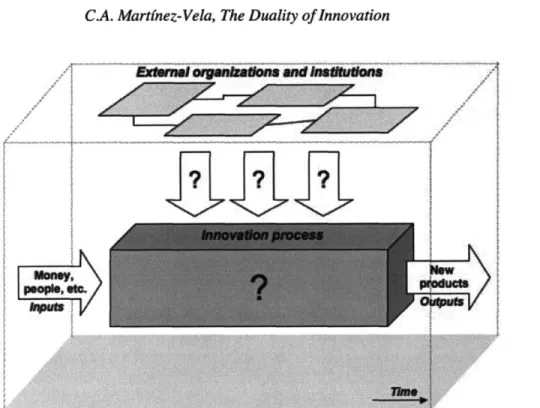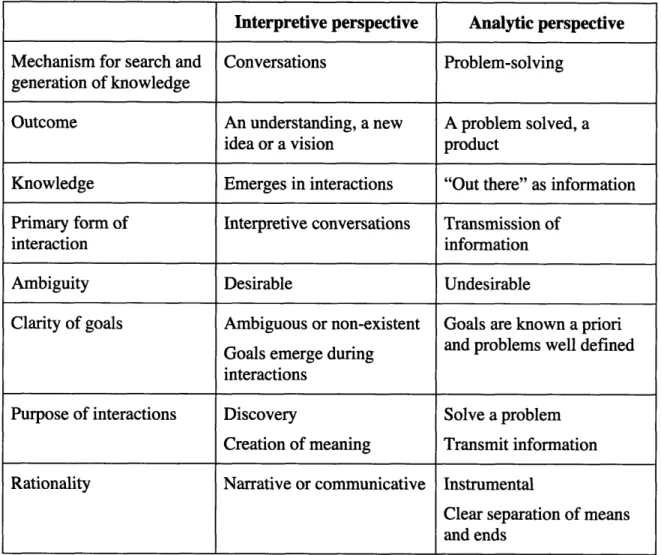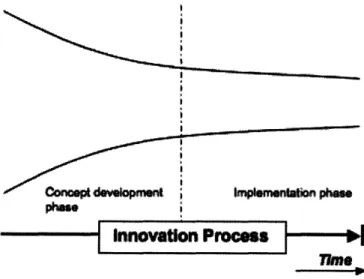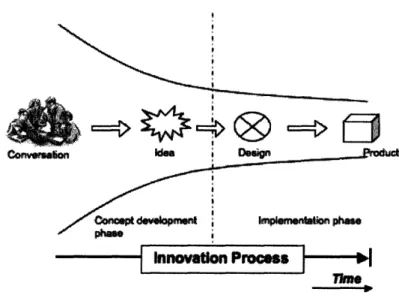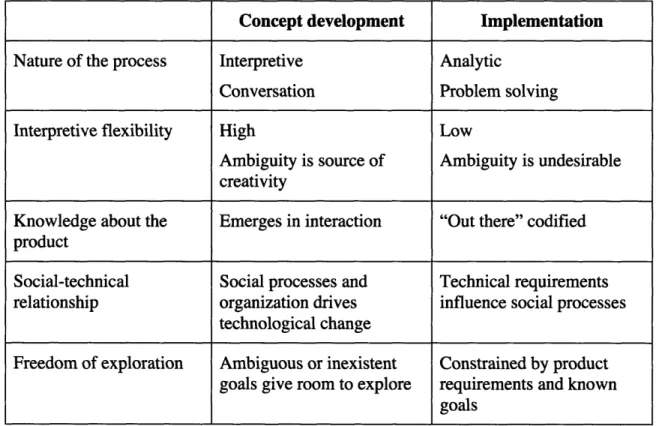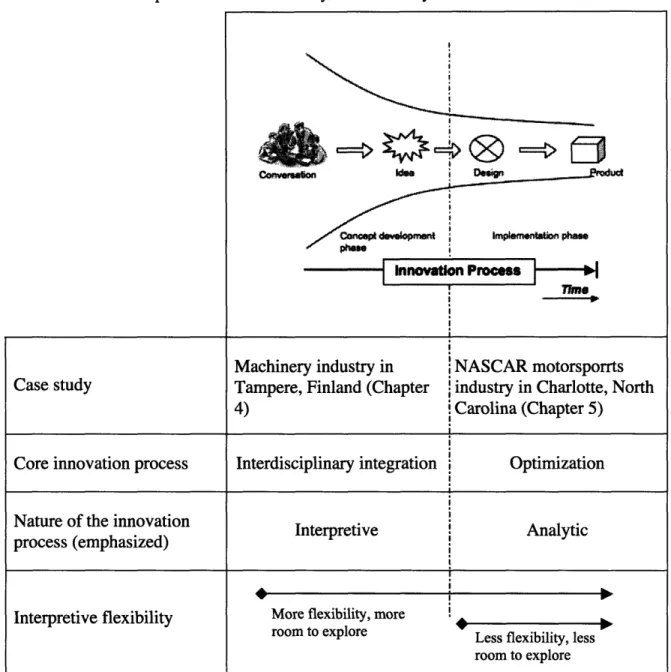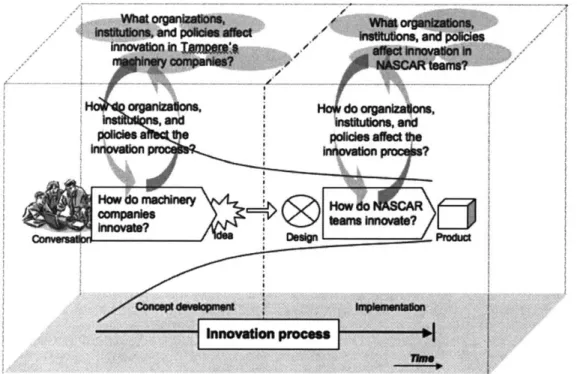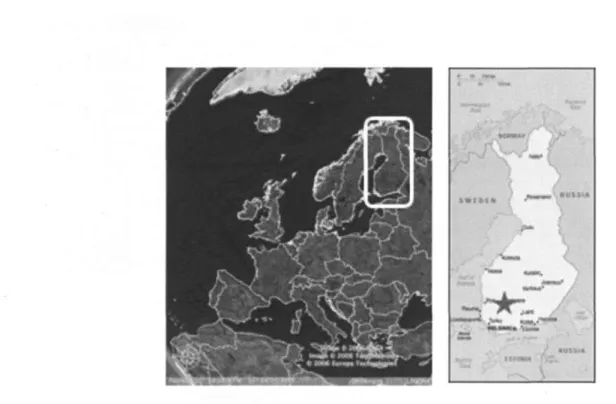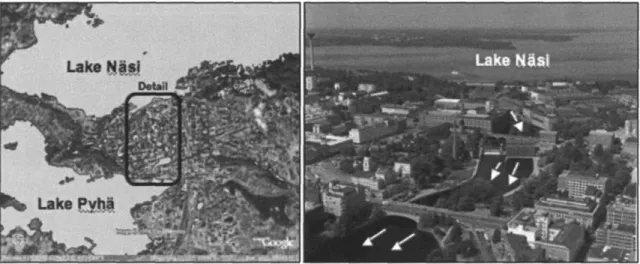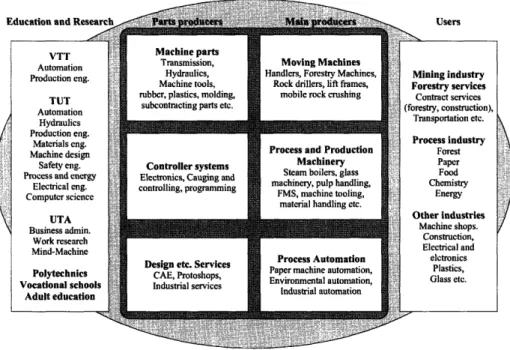The Duality of Innovation:
Implications for the Role of the University in Economic Development by
Carlos Andres Martinez Vela
B.Sc., Engineering Physics ITESM. Monterrey, Mdxico, 1995
S.M. Technology and Policy. MIT, 1998
Submitted to the Engineering Systems Division In Partial Fulfillment of the Requirements for the Degree of Doctor of Philosophy in Technology, Management and Policy
at the Massachusetts Institute of Technology February, 2007
C 2007 Massachusetts Institute of Technology. All Ri Re rved
Signature of the Author: ... ... ...
Engine ri Systems Division vember 27, 2006
Certified by:... ...
Richard K. Lester Professo f u ar Science and Engineering Thesis Suptrvisor and Directp'IWMy1 Performance Center, MIT
C e rtifie d b y : .. --- - -- --- ---- --- ---- --- ----. ----..-- ---
-David A. Mindell Francis and David Dibner Professor of the History of Engineering and Manufacturing Director, Program in Science, Technology, and Society, MIT Certified by: --r---.
.-...-.-.--.---Michael J. Piore
David W. Skinner Professor of Political Economy /P Dfpartments of Economics and Political Science, MIT
Certified by:
.Markku
Sotarauta Professor of Regional Studies and Director, Research Unit for Urban and Regional Development Studies, U. of Tampere, Finland A ccepted by : ... ... ... .. ...
Richard de Neufville / 1ofessor of Engineering Systems
TECHNOLOGY h
I hair, ESD Education Committee, MIT
FEB 28 2007
LIBRARIES
ARCHIVES
MASS OF'
C.A. Martinez-Vela, The Duality of Innovation
The Duality of Innovation:
Implications for the Role of the University in Economic Development by
Carlos Andres Martinez Vela
Submitted to the Engineering Systems Division on November 27, 2006 In Partial Fulfillment of the Requirements for the Degree of Doctor of Philosophy in Technology, Management and Policy
Abstract
The university is increasingly seen as an engine of regional economic development. Since the 1980s the university's role has been framed in terms of its contribution to industrial innovation. The conventional wisdom views this contribution as occurring primarily through the technology transfer model. The university, in this way of thinking, must move closer to industry and the marketplace by translating research into deliverables for commercialization. This dissertation challenges the empirical validity of this view.
Two case studies of industrial upgrading form the empirical core of this research: the machinery industry in Tampere, Finland and the NASCAR motorsports industry in Charlotte, North Carolina. In each case I analyze the university's role from the ground up using a conceptual framework that views the innovation as a social process that has a dual nature: analytic and interpretive. From an analytic perspective innovation is a problem-solving activity. From an interpretive perspective innovation is an ongoing conversation.
I find that in neither case is the university's most important contribution to each
industry's upgrading made through the technology transfer model. In Tampere, whose core innovation process is interpretive, the local university creates spaces for interaction and conversation that enable knowledge integration, provides interlocutors for exploratory conversations, and educates engineers. In Charlotte, whose innovation process is analytic, the local university plays essentially no role. NASCAR teams rely on business partners for technology transfer and attempts to make the university active in technology transfer for the industry have yet to succeed.
The duality of innovation helps to explain the university's role in the Tampere case and its absence in the Charlotte case. I argue that the technology transfer model implicitly assumes that innovation is analytic and thus misses the interpretive side of innovation. The case study findings suggest three things. First, the university has a distinctive ability to make interpretive contributions to industrial innovation. Second, practices emphasized
by the technology transfer model, such as patenting and technology commercialization,
do not account for the university's interpretive role. Third and finally, too much emphasis on the technology transfer model may put at risk the university's interpretive capabilities and hence its most distinctive contribution to industrial innovation.
Thesis Supervisor: Richard K. Lester
Title: Professor of Nuclear Science and Engineering Director, MIT Industrial Performance Center
C.A. Martinez-Vela, The Duality of Innovation
Acknowledgements
I was asked recently what is the origin of my love for the university and I could not give
an answer. I later thought that the university has been part of my existence since before I was born. My two grandfathers and my father were (among other things) academics and Deans in the School of Medicine at the University of Nuevo Le6n in Monterrey, Mexico, my hometown. Through my mother I was exposed to the university since before I was born. She found out she was pregnant with me the same day she was granted a scholarship to begin college. She would go on to pursue graduate studies and become an academic herself. Through both my father and my mother I experienced what it means to have a passion for higher learning.
But my belief in the university and my desire to understand its transformative and humanizing power in society is, in the end, my own. It started in my college years at Monterrey Tech, when I was deeply involved in student life. It was nurtured there after I finished college, when I discovered how much I love teaching, how academic research can contribute to innovation, and how challenging it is to manage a university. In the Fall of 1996 1 came to MIT for the first time with only an incipient interest in better understanding the role of the university in economic development. Since then, the university has been a consistent companion in my life and has been joined by a deep fascination with the how people innovate. The road has been neither straight nor easy. Along the way, there were many without whom this document would not be what it is and perhaps would not exist altogether.
The first note of gratitude goes to my dissertation committee. Richard Lester, my advisor, welcomed me into the MIT Industrial Performance Center. He created the conditions without which this pursuit would not have been possible: financial support, physical space, interesting problems, a community of scholars, intellectual inspiration, endless curiosity, pragmatism, challenge, honesty, trust, and a lot of patience. Without Michael Piore's friendship, trust, patience, insight, honest critique, and unwavering support and guidance in times of personal and intellectual discovery, consolation, and desolation, I would not be writing this sentence. I am indebted to Richard and Michael for introducing me to the duality of innovation. David Mindell sowed the inspiration to enter the fascinating world of the history and sociology of technology. His belief in my work, insightful feedback, and financial support in the last stage of this work were vital to bring this to completion. Markku Sotarauta has made possible my close and continuing involvement with Finland. In Tampere he provided not only a fascinating intellectual endeavor. He made me part of a welcoming community of scholars and friends. His expertise on regional development issues has been fundamental. During the early stages of my doctoral work the intellectual guidance and support of Richard Chait from the Harvard Graduate School of Education, were essential to deepen my understanding of the complex tasts of managing, leading, and transforming a university.
This dissertation stems from my participation in the Local Innovation Systems Project, an international research partnership based at the MIT Industrial Performance Center. Having been part of this project made me able to pursue this research. My Local
C.A. Martinez-Vela, The Duality of Innovation
Innovation Systems Project colleagues made countless contributions to this intellectual endeavor through their ideas and friendship. I thank you all. I am especially grateful to Kimmo Viljamaa from the University of Tampere. We made a good part of our fieldwork in Tampere and Charlotte jointly and wrote early case study drafts together, enriching and motivating each other's intellectual growth. Most importantly, out of this collaboration grew a friendship for life.
My intellectual and personal experience at the MIT Industrial Performance Center
was made joyful and enriching by my colleagues Dan Breznitz, Teresa Lynch, Sara-Jane McCaffrey, Ben Pinney, Sean Safford, and Smita Srinivas. Without Anita Kafka's motherly care, warm presence and administrative support it would not have been the same to be at the IPC every day. Before he left the IPC, Scott Shurtleff's friendship and professionalism made a difference. I am grateful to Alok Chakrabarty from the New Jersey Institute of Technology and former visiting scholar at the IPC, for providing the initial motivation to go to Finland, a country that I now consider an integral part of my personal, intellectual, and cultural growth during my Ph.D. studies. The numerous times I went there would have been very different without my colleagues Kati-Jasmin Kosonen, Juha Nummi, and Katja Lahenius.
The task of grounded research took me to some fascinating places and to meet numerous individuals whose insights form the basis of this dissertation. In Tampere and Charlotte, I express my gratitude to many managers, engineers, policymakers, craftsmen, professors, and academic administrators who made time to openly share their insights and experience. In Charlotte, I am especially grateful to Steve Boyer, Jim Cuttino, Doug Duchardt, Gene Haskett, Ed McLean, Melanie O'Connell-Underwood, and Andy Papathanassiou for opening doors, for our conversations, and for helping me enter and begin to understand the world of motorsports, fueling what has become a deep
intellectual fascination.
My Ph.D. studies have been made possible through the financial support of the MIT
Industrial Performance Center and the various grants that supported the Local Innovation Systems Project. These include grants from the Finnish Funding Agency for Technology and Innovation (Tekes), the Cambridge-MIT Institute, the Alfred P. Sloan Foundation, the National Science Foundation, and the Research Council of Norway. My studies were also supported through a Sloan Foundation Doctoral Fellowship and a Martin Family Fellowship for Sustainability. Early on I received support from the United States
-Mexico Foundation for Science. In the last months of this pursuit, I received stipend support from the Cambridge-MIT Institute's Program on Regional Innovation and the MIT's Program in Science, Technology and Society. I am grateful to these sources of funding for enabling this pursuit. I also thank my parents for their additional support to my quality of life and my brothers Angel and Francisco for their contributions in times of need.
Good coffee, good dinner, good wine, good beer, and good music surrounded many conversations with good friends about life in the world and the life of the mind. I especially thank Jean-Jacques Degroof, Maria Elosn'a, Nils Fonstad, Sebastian Fixson,
C.A. Martinez-Vela, The Duality of Innovation
Sachi Hatakenaka, Natasha Iskander, Sarah Kaplan, David Sirkin and Patrick Steinemann for the many meaning-creating moments that we shared. Adding to all of the good things of friendship, Leonela Gonzilez, Enrique Guinand, Genevieve Connors, Katie Overy, Alexander van der Linden, Virginia Best, and Laurent Baggioni made my dwelling a home.
None of these experiences would have been possible without the support of my home department at MIT, the Engineering Systems Division. Professor Richard de Neufville's vision in creating the Technology and Policy Program opened the possibility for my attendance to MIT, initiating years of intense intellectual and personal growth in a collegial environment of unparalleled richness and challenge. I am thankful for his support to return to MIT to pursue doctoral studies and his confidence in my ability to succeed. MIT's commitment to excellence is also reflected in its administrative support. Sydney Miller and Beth Milnes in the Engineering Systems Division, and Aurora Brule in the International Student Office were calming voices, empathetic ears, and valuable guides that helped me navigate the administrative transition from student to professional.
When I started this dissertation I was told that more than a test of intelligence it is a test of emotional endurance. It certainly is. Within the isolation this test requires there are those whose understanding, patience, companionship and paho de /dgrimas make it possible to endure the test. Dr. Jaine Darwin's professionalism and support throughout
my Ph.D. years gave me a space to come to terms and come to terms with the inner and outer realities of my life. The first dedication of this dissertation goes to her. Alma Maldonado was an essential presence in my life. Her fraternal love, enduring friendship, Mexicanity, sense of humor, tantrums, passion for life, politics, telephone, nightline, and wake-up call requests were a keystone in my ability to endure this test. Blanca Raymundo's virtual messages and real friendship that transcends the test of time and the tries of life were fundamental. Erica Fuchs witnessed my work on a day-to-day basis and channeled her endless dynamism, friendship, advice, dedication, and good taste for restaurants to my life stream, inspiring me to not give up. Benjamin Baum's unwavering friendship, companionship, bravery, patience, presence and final edits lit the tunnel from beginning to end.
From a distance, the continuous presence of my brothers and sisters has been a continuous source of inspiration and understanding. I thank you all. A special note of thanks goes to my nieces Adriana, Alejandra, Mariana, Maribel and Talis whose friendship, love and joy for life enlighten and lighten my life in a unique way.
This dissertation is dedicated to my parents Angel and Atala. Their endless and resilient supply of love has been anchoring family, strong pillar, quality of life, safe refuge, certain home, warm embrace, voice of experience, weathering patience, questioned authority, launching platform, freedom to be and freedom to love.
C.A. Martinez-Vela, The Duality oftInnovation 9
Table of contents
I INTRO D UC T IO N ... 19
1. 1 T H E D UA LITY O F INNO V ATIO N ... 24
1.2 T HE D ISSERTA TIO N ... 25
1.3 BRINGING THE INNOVATION PROCESS BACK IN...29
1.4 OVERVIEW OF TH E DISSERTATION ... ... 31
2 RESEARCH APPROACH AND ASSUMPTIONS...33
2.1 THE PARADIGM S OF SOCIAL RESEARCH ... 33
2.2 QUALITATIVE RESEARCH ON INNOVATION SYSTEMS ... 36
2.3 INTERPRETIV E RESEA RCH ... 37
2.4 INTERPRETIVE RESEARCH AND TECHNOLOGY... ... 41
2 .5 C A SE ST U D IES ... 4 4 2.5. 1 Research process and logic of exploration... 47
2 .5.2 C ase selection ... 48
2.5.3 Level of/analysis and unit of analysis ... ... 54
2 .5.4 D a ta co llectio n ... 55
2.6 BUILDING THEORY FROM CASE STUDIES... 60
2.6. 1 A nalysis and within-case theorizing ... 60
2.6.2 Cross-case theory building ... ... 65
2.7 TRANSFERABILITY, VALIDITY AND VERISIMILITUDE ... 69
2.7.1 Validity and verisimilitude... 70
3 THE DUALITY OF INNOVATION ... 75
3 .1 IN T RO D U C TIO N ... 75
3.2 T HE DUA LITY OF INNOVATION ... 77
3.2. I Interpretation: innovation as an ongoing conversation... 79
3.2.2 Analysis: innovation as a problem-solving activity ... 82
3.2.3 Tw o ep istem olog ies... 83
3.3 THE DUALITY OF INNOVATION AND THE PRODUCT LIFECYCLE ... 85
3.4 INTERPRETIVE FLEXIBILITY AND CLOSURE ... 91
3.5 POSITIONING THE CASE STUDIES... 95
4 MAKING SPACE FOR INNOVATION: HOW THE MECHANICAL ENGINEERING INDUSTRY IN TAMPERE, FINLAND, BECAME HIGH-TECH ... 101
4 .1 IN T RO D U C TIO N... 10 1 4.2 TECHNOLOGICAL CHANGE IN TAMPERE'S MACHINERY ... 110
4.2.1 Meka Tree: Forest harvesting machines... ... 112
4.2.2 MekAutomation: Process automation ... ... 117
4.2.3 Innovation through interdisciplinary integration ... 119
4.3 T HE IN NO VATIO N PRO CESS... 12 1 4.3.1 Making space/for innovation ... ... ... ... .... 122
4.3.2 Envisioning fi ture products and markets ... 124
4.3.3 F ocusing on the long-term ... 127
4.3.4 Managing and preserving ambiguity... ... 129
4.3.5 Interdisciplinary integration: an interpretive process... ... ... 132
4.4 EFFECTS OF THE INSTITUTIONAL SET-UP ON THE INNOVATION PROCESS... 135
4.4.1 The Tampere University of Technology... 136
C.A. Martinez-Vela, The Duality of1 Innovation 10
4 .4 .3 T ek es ... 1 4 3 4 .4 .4 O th er p o lic ro les ... 14 6 4.4.5 Inf rm a l institutions... 1 48
4.5 UNDERSTANDING THE UNIVERSITY'S ROL ... ... 50
4 .6 D ISC U SSIO N ... 15 6 5 SPEED MATTERS: INNOVATION IN THE NASCAR MOTORSPORTS INDUSTRY...161
5 .1 IN T R O D U C TIO N ... 1 6 1 5.2 OVERVIEW OF TECHNOLOGY AND ORGANIZATION ... 172
5.2.1 Motorsports: technical and deeply hunan ... 1 78 5.3 THE INNOVATION PROCESS... 180
5 .3 .1 O p tim izing ... 1 82 5 .3.2 E xp erim enting ... 1 8 7 5.3.3 Trans/brining innovation ... 189
5.3.4 Blending craft and science... 196
5.3.5 C om ing tog ether ... 199
5.4 EXTERNAL INTERACTIONS AND EFFECTS . ... 201
5.4.1 Analytic interactions and iinctions ... ... 203
5.4.2 Interpretive interactions andfunctions... ... ... 209
5.5 UNDERSTANDING THE ABSENCE OF THE UNIVERSITY ... 211
5.5.1 Innovation process incompatibility... 216
5.5.2 The duality of innovation, UNCC, and NASCAR teams ... 219
5 .6 D ISC U SSIO N ... 2 2 1 5.6. 1 Building research collaborations ... ... 222
5.6.2 Building educational collaborations ... ... 223
5.6.3 Collaborating with NA SCAR and suppliers... 225
5.6.4 Preparingfr the fiture... ... 226
5 .7 C O N C LU SIO N ... 2 29 5 .7.1 W hy cluster? ... 2 3 0 5.7.2 Does public investment in the motorsports industry make sense?... ... 232
6 CONCLUSION...237
6.1 TERMS OF ENGAGEMENT ... 247
7 LIM ITATIONS AND FURTHER RESEARCH ... 255
C.A. Martinez-Vela, The Duality of Innovation
List of Figures
Figure 1-I The black box of innovation . ... 30
Figure 3-1 The two phases of innovation . ... 87
Figure 3-2 From ideas to products in the two phases of innovation ... 89
Figure 3-3 Logic of exploration in each case study...100
Figure 4-1 Location of Tam pere, Finland ... 103
Figure 4-2 T he Tam m er R apids ... 104
Figure 4-3 Tampere's mechanical engineering industry ... 107
Figure 4-4 Rock-drilling and container handling machines ... 111
Figure 4-5 Forest harvesting m achine ... 116
Figure 4-6 Interdisciplinary integration at the heart of innovation...120
Figure 4-7 Interpretive space...122
Figure 4-8 How do external interactions affect interdisciplinary integration?...134
Figure 5-1 Professional NASCAR teams in the Charlotte, NC region ... 167
Figure 5-2 The front of a stock-car ... 173
Figure 5-3 Side view of a stock-car ... 173
Figure 5-4 Example of the stock-car's "set up" ... 175
Figure 5-5 NASCAR motorsports is a deeply social endeavor ... 179
Figure 5-6 NASCAR teams have an extremely analytic innovation process ... 183
Figure 5-7 NASCAR officials using one of the 33 templates . ... 186
Figure 5-8 The need to react as fast as possible goes to extremes ... 189
Figure 5-9 Organizations that affect the innovation process in NASCAR teams ... 202
Figure 5-10 The post-race engine teardown ... 205
Figure 5-11 NASCAR teams have all their innovation support covered ... 220
C.A. Martinez-Vela, The Duality of Innovation 13
List of Tables
Page Table 3-1 A comparison of the interpretive and analytic perspectives on innovation. ....85 Table 3-2 The relationship between the duality of innovation and the product lifecycle. 95 Table 3-3 Relationship between each case study and the duality of innovation...99 Table 4-1 Some leading engineering companies in the Tampere region...108 Table 6-1 Com parison of innovation process...245
C.A. Martiiec-Vela, The Duality (?f Innovation
List of Acronyms
CNC Computer Numerical Control
CoT Car of Tomorrow
ICT Information and Communications Technologies IHA Institute for Hydraulics and Automation
LIS Local Innovation Systems
MIT Massachusetts Institute of Technology
NASCAR National Association of Stock Car Auto Racing R&D Research and Development
Tekes Finnish Funding Agency for Technology and Innovation TUT Tampere University of Technology
UNCC University of North Carolina at Charlotte VTT Technical Research Center of Finland
C.A. Martine,-Vela, The Duality of Innowition 17
Believing is where learning starts. We know first, act on such knowledge and then get to know more. We may acquire sharper knowledge, built around reasons, causes and calculations, or vaguer knowledge, in which hopes, enigmas and alluring problems form the thread. The two ways often go together, for the activity of getting to know is compounded of feelings as well as of intellectual curiosity, of hunches as well as of facts.
- Robin A. Hodgkin
Playing and Exploring:
C.A. Martinez- Vela, The Duality of Innovation
I
Introduction
Since the 1950s innovation policy has been formulated with two predominant models of innovation in mind. Each model is closely associated with a theory about the relationship between technology and the economy and a guiding rationale for the design and implementation of science and technology policy.
The first model is the linear model of innovation. In this model innovation flows sequentially from basic research to applied research, product development, and finally the marketplace. This model, sometimes referred to as "science-push," was set out for the first time in Vannervar Bush's now classic report, Science: The Endless Frontier (Bush,
1945). The linear model is associated with the market-failure rationale for government
involvement in the promotion of innovation (Branscomb and Florida, 1998; Mowery and Ziedonis, 1998). This rationale was theoretically justified first by Arrow (1962) and later
by endogenous growth theories (Romer, 1990).1 The policy instrument associated with
the linear model and market-failure rationale is public investment in basic research, which would eventually translate into economic prosperity (Martin, 2003).
The second model is the interactive or systems model of innovation. In this model the interaction of multiple individuals, organizations, and institutions results in more innovation. This model is associated with the systems-failure rationale for policy design and implementation (Lipsey, 1998; Edquist, 2001; Teubal, 2002), theoretically justified
by the innovation systems approach (Lundvall, 1992; Nelson, 1993; Edquist, 1997). In a
' Mowery (2005) suggests that Bush's argument anticipated the market-failure rationale that Arrow (1962) would later articulate.
C.A. Martinez-Vela, The Duality of Innovation
conceptual shift from its neo-classical predecessors, this approach builds on evolutionary theories of the economy and technological change (Nelson and Winter, 1974; Nelson and Winter, 1982), and gives a prominent role to institutions in the process of innovation (Edquist and Johnson, 1997; Moreau, 2004). In addition to investment in basic research, this rationale's policy prescriptions also include the creation of organizations and institutions (the "institutional set-up for innovation"), and the implementation of policies and incentives to foster interactions among the components of an innovation system (Edquist and Johnson, 1997; Edquist, 2001).
Views about the role of the university in regional economic development and the public policies to foster that role follow the changing models of innovation.2 In The
Endless Frontier, Vannevar Bush articulated a vision in which the university's
contributions to the economy and society emanated primarily from basic research and called for a more active government role in funding basic academic research. Between 1945 and the late 1980s the linear model combined with the market-failure rationale were the bases for policies that focused government investment in basic research in academia
2 Attention to the university's role in economic development is not new. Prior to 1945, the expansion of American higher education that began in the mid 19th century was fueled, at least in part, by such an idea
(Lee, 1996). With the passage of the Morrill Act of 1862, the origin of what today are known as "land-grant" higher education institutions, the Federal government granted land to each state to create and maintain "at least one college where the leading object shall be, without excluding other scientific and classical studies, . . .to teach such branches of learning as are related to agriculture and the mechanical arts" (Hofstadter, 1961 as cited in Geiger, 1986 #360). Universities also had close ties with industry in the late 19' century and up until the 1930s. Fields such as electrical and chemical engineering were developed within universities as a response to technical development in industry (Rosenberg and Nelson, 1994), with MIT a flagship example of close ties with industry during that period (Matkin, 1990). A shift in the idea of how a university contributes to economic development and its relations with industry took place during and after WWII.
C.A. Martinez-Vela, The Duality of Innovation
(Martin, 2003). This investment was deemed necessary and sufficient to promote innovation (Mowery and Sampat, 2005).
The view of the university's role in economic development evolved with the emergence of endogenous growth theories. In this view academic research creates "knowledge spillovers" that would ultimately benefit the economy (Jaffe, 1989; Jaffe, Trajtenberg et al., 1993; Feldman, 2000; Feldman, Feller et al., 2002). Further evolution in our understanding occurred with the emergence of interactive and systems views on innovation. The perception about the university's contribution to economic development changed from the post-WWII emphasis on basic research to comprise more direct contributions to industrial innovation.3 The "Mode 2" (Gibbons, 1994) and "Triple Helix" (Etzkowitz and Leytesdorff, 1997; Etzkowitz and Leydesdorff, 2000) perspectives adopt a highly interactive view of the university in relation to communities of academic researchers and practitioners in other organizations, and between the universities, government agencies, and companies. In the innovation systems approach, universities are crucial components of the system and play a key role in enhancing the innovative capacity of business and the overall system performance (Nelson, 1993; Edquist and Johnson, 1997; Feldman, Feller et al., 2002; Mowery and Sampat, 2005).
3 The rise of Japan and other newly industrialized economies in Asia prompted a shift in discourse towards the idea of competitiveness and innovation in science and technology policy (Branscomb and Florida, 1998). The competitive advantage of those countries was perceived to be technological innovation. There was also empirical evidence that such advantage stemmed not just from investment in research, but from an institutional framework conducive to innovation. In particular, interactions between industry, government agencies and public research and educational institutions were key to building this advantage (Freeman,
1995; Nelson, 2000; Saviotti, 2001). At the same time, innovation became more distributed, involving the
interactions of multiple organizations and sources of knowledge and technology (Lundvall, 1985; Lundvall, 1992; Gibbons, 1994).
C.A. Martinez-Vela, The Duality of Innovation
The current wave of interest in the university's role is usually framed in terms of their contribution to the formation and strengthening of "high-tech" innovation-intensive geographically concentrated industries (Mowery and Sampat, 2005).4 With the rise of the "knowledge economy" and "technology-based economic development" universities embrace a "third mission" of regional economic development to supplement research and education. This transformation in has been referred to as a change in the social contract for higher education (Guston and Keniston, 1994; Martin, 2003) and a "second academic revolution" that is moving universities from an ivory tower to an entrepreneurial paradigm (Clark, 1998; Etzkowitz, Webster et al., 2000).
At the heart of the "new social contract" is the idea of technology transfer, which has rapidly become the model of how the university contributes to industrial innovation.5 The meaning of technology transfer is hard to pin down since it is used in multiple ways
4 The theory of "industry clusters" articulated by Porter (1990) triggered interest in initiatives to build
clusters anchored by universities. Two empirical examples are usually cited as the models: first, the past development of Route 128 and the current growth of life sciences in Boston, with MIT and Harvard acknowledged as major contributors to their growth. The second example is Silicon Valley in California's Bay Area, in which Stanford is credited with a crucial role in the development of the information technology industry (see Saxenian, 1994 for a classic analysis of both Boston and the Bay Area). More recently the life sciences industries around San Diego, California and the Research Triangle (Raleigh-Durham area) in North Carolina are also cited as examples and used as models. The regional emphasis on the university's role is not new. In the U.S. regionalism has been a defining characteristic of higher education since the establishment of the first land-grant universities, many of which developed research and educational programs focused on regional economies, at least initially (Feller, 1999).
' In the United States patenting by universities started as early as 1925 and increased during the 1970s (Matkin, 1990; Mowery and Sampat, 2005). Around 1980, Federal and State policies began to actively foster technology transfer. At the Federal level, the passage of the Bayh-Dole Act of 1980 legitimated university patenting and technology transfer as a tool for economic development. Today virtually all states have some type of "technology creation" policies or program that promote university-industry partnerships, and tap into higher education institutions to attract and create high technology industries, foster the growth of industry clusters, and the formation of start-up firms (Geiger and Sd, 2005). University technology transfer policies and practices spread rapidly on a global scale. Many OECD and less developed countries have created policy frameworks to emulate the Bayh-Dole Act and to organize practices like science and technology parks and the creation of university technology transfer offices and business incubators. In all emulations there is an emphasis on intellectual property rights and technology commercialization as a way to foster the university's role in regional economic development (Mowery and Sampat, 2005).
C.A. Martinez-Vela, The Duality of Innovation
(Matkin, 1990; Bozeman, 2000), so it is best defined by its meaning in practice. What I will refer to as the technology transfer model entails a very specific set of practices that prescribe an ideal view of how universities contribute to industrial innovation. When policymakers and academic administrators talk about technology transfer, they refer to the translation of research into patents and products that can be taken up by existing enterprises to improve their processes and product offerings, or taken up by entrepreneurs to form new businesses. The keystone of the technology transfer rationale is intellectual property. In an academic setting, intellectual property entails codifying research results into patents that are then made available through licensing. Three organizational arrangements are usually associated with technology transfer initiatives in higher education technology transfer or technology licensing offices: business incubators to nurture new businesses or "start-ups," industrial liaison programs, and the creation of technology or science parks. These initiatives "share the premise that universities support innovation in industry primarily through the production by universities of 'deliverables' for commercialization (e.g., patent discoveries)" (Mowery and Sampat,
2005, p.225).
Behind the technology transfer model there is a working assumption about the nature of interactions over the course of the innovation process. While the innovation systems approach has involved a shift from a linear to an interactive model of innovation, the understanding of technology transfer interactions among individuals and organizations is very narrow. In the linear model, the assumption is that innovation involves primarily the flow of information from one stage of the innovation process to the next. The interactive
C.A. Marttnez-Vela, The Duality of Innovation
model of innovation has taken this model to the innovation systems level, where the focus is on creating and enhancing flows of information among the organizations of the innovation system. The current focus is, in addition, on the transmission of information via market interactions.
1.1 The duality of innovation
Recent research suggests there is a fundamental duality in the innovation process that has important implications for innovation policymaking and the university's role in enhancing industrial innovation. An early articulation of what I will refer to as the
duality of innovation is Schn's description of innovation as a rational and a non-rational
process (Sch6n, 1967) and between reflective practice and technical rationality (Sch6n,
1983). More recently, Lester, Piore, and Malek (Piore, Lester et al., 1994; Lester, Piore
et al., 1998; Malek, 2000; Lester and Piore, 2004) propose the terms interpretation and
analysis to characterize two different "dimensions" of the innovation process, both
closely related to SchSn's characterization. I will use these two terms in the rest of this study to refer to each aspect of the duality of innovation.
From an interpretive perspective, innovation is an inherently social process. Innovation unfolds as an ongoing, open-ended conversation in which new ideas and artifacts emerge over time through the language and actions of practitioners-interlocutors. The goals of the conversation are fuzzy or not known at all at the start. Knowledge about the product emerges in practice and social interaction.
C.A. Martinez-Vela, The Duality of Innovation
From an analytic perspective, technological change unfolds as practitioners solve a sequence of problems presented to them by product designs that are already "out there." Goals are clear at the start of problem-solving, and the point is to act rationally using the appropriate means to reach the specified goals. In this case no new knowledge emerges in interactions. While one interlocutor might learn something new, his or her learning comes from the acquisition of knowledge that already exists codified as information.
From an innovation policy perspective, the duality of innovation suggests two radically different ways the university may enhance industrial innovation. First, from an interpretive perspective, the university would enhance conversations that lead to the emergence of new knowledge. Second, from an analytic perspective, the university would enhance problem solving and information dissemination. Thus, unlike the linear and interactive models of innovation that underpin the technology transfer model, the duality of innovation offers a more nuanced way to examine the university's contribution to industrial innovation and its role in economic development.
1.2 The dissertation
This dissertation takes a step towards understanding the implications of the duality of innovation for innovation policy and for the university's role in regional economic development. To do this, I follow an inductive, qualitative, and comparative case-based approach (as described in Chapter 2) of two locales that are representative examples of local innovation systems. Local innovation systems are defined as
spatial concentrations of firms (including specialized suppliers of equipment and services and customers) and associated non-market institutions (universities, research institutes, training
C.A. Martinez-Vela, The Duality of Innovation
institutions, standard-setting bodies, local trade associations, regulatory agencies, technology transfer agencies, business associations, relevant government agencies and departments, etc.) that combine to create new products and/or services in a strategically distinct business. (Braczyk, Cooke et al., 1998)
The first case is a study of innovation in the machinery industry concentrated in the city-region of Tampere, Finland. The region is home to approximately one dozen companies that are leaders in their global market niches, ranging from forest harvesting machinery, to glass manufacturing machinery, to paper machinery automation systems. The second case study examines the NASCAR motorsports industry concentrated near Charlotte, North Carolina. The region is home to the vast majority of professional
NASCAR teams and to more than 450 supporting businesses. In both cases, the industries under study may be seen as traditional industries in the region, in the sense that their origins in these locales are decades old. As such, both cases are illustrations of
innovation-based industrial upgrading. I define innovation-based industrial upgrading as
the process by which companies in an established industry absorb technical and scientific knowledge, product development techniques, and production technologies previously alien to the industry and integrate them into an existing base of processes and products, yielding enhanced production processes, improved product performance, novel product functions and/or uses that result in sustained or expanded competitiveness and business opportunities.
While Tampere's machinery industry and Charlotte's NASCAR motorsports industry are both cases of innovation-based industrial upgrading, there are two fundamental differences between them. First, the innovation processes that have driven upgrading are
C.A. Martinez-Vela, The Duality of Innovation
radically different and are representative of each side of the duality of innovation. In Tampere, the core innovation process behind industrial upgrading is interdisciplinary
integration, which entails the integration of electronics, control, information, and
communications technologies into the machines. This process, I will demonstrate, is primarily interpretive. In Charlotte, the core innovation process behind industrial upgrading is optimization, in which NASCAR teams are working within a tightly regulated product architecture to optimize racecar performance. I will show that this process is primarily analytic.
The second difference between the cases is the institutional setup for innovation in each industry. In Tampere, a local set of innovation-supporting non-market organizations has been critical to the ability of local companies to reinvent themselves. More specifically, the Tampere University of Technology (TUT) has been critical to the ability of machinery companies to take up and integrate new technology into machinery, both through research and education. The interactions between TUT and the local machinery industry are a model of a fruitful university-industry relationship. However, the interactions contributing to industrial upgrading through interdisciplinary integration look nothing like the technology transfer model. In Charlotte, on the other hand, not a single local innovation-supporting non-market organization helped to enable local NASCAR teams to remain competitive. Interactions similar to the technology transfer model are important for the industry's continuous upgrading, but NASCAR teams rely primarily on suppliers and the racing divisions of auto manufacturers to take up new technology and solve problems. The local research university, the University of North Carolina at
C.A. Martinez-Vela, The Duality of Innovation
Charlotte (UNC Charlotte), even though it has a research and education program in motorsports and automotive engineering, has played no role in the industry's upgrading. Recent efforts by local civic, government, and industry leaders to bring UNC Charlotte and NASCAR teams closer together in innovation-supporting partnerships did not work.
Through these two case studies I address the following research questions:
e What are the implications of the duality of innovation for the university's role
in economic development and university-industry interactions?
- How do variations in the innovation process affect the role that the university plays in one case and its absence in the other?
o In Tampere, where the university plays a critical role, what is the university doing, if not technology transfer?
o In Charlotte, where technology transfer is crucial to upgrading, why is the university absent?
In this dissertation I use "the university" as a proxy for an organizational actor within innovation systems. I acknowledge that this is an idealization. Universities are complex organizations in which multiple departments, schools, and research centers pursue different agendas. The university's creative energy comes from independently-minded and driven individuals. In this sense, my use of "the university" should not be taken to mean that the multiple actors that constitute a university act monolithically. Universities also vary along the dimensions of research intensity, the balance between basic and applied research and the balance between teaching and research activities. Different
C.A. Martinez-Vela, The Duality of Innovation
universities too, have different levels of commitment to economic development and industrial innovation. The university's role in economic development, as the case studies in this thesis will show, occurs at the level of individual departments, research centers, and personal relationships between academic researchers and industry practitioners. My use of "the university" is thus a simplification.
1.3 Bringing the innovation process back in
I propose that in order to understand the implications of the duality of innovation it will
be necessary to provide additional insights into the nature of the innovation process. Most studies of innovation policy and innovation systems focus on inputs (e.g. research dollars, trained professionals), outputs (e.g. patents, new products), and on how interactions between organizations, institutions, and firms affect the ability of the system to yield more outputs. However, what goes on between the inputs and outputs remains a black box. In other words, the innovation process itself - how practitioners actually innovate and how the individuals, organizations, and institutions interact over time during the innovation process - is missing from policy discussions in general, and from university-industry partnerships in particular. As a consequence, we cannot really say how universities actually affect the innovation process of firms or how differences in the innovation process reflect in university-interactions and the actual role that universities play to support the innovation process.
CA. Martfnez-Vela, The Duality of Innovation
Figure 1-1 Most studies of innovation systems and in general, of the effects of organizations and institutions in enhancing regional innovation, do not examine the innovation process.
To overcome this limitation I approach each case from the ground up. First, I introduce
the context in which the two local industries are located, including a brief characterization of each industry's structure and anchoring firms. Second, I open up the
black box of innovation to examine more closely the nature of the innovation process in each industry. To do this I rely on interview data, secondary sources, and observation in a subset of companies within each locale. Third, I examine external interactions and innovation-support organizations that play critical roles in each industry's innovation process. In Tampere, I focus on external interactions that affect the process of interdisciplinary integration in machinery companies. In Charlotte, I focus on external interactions and organizations that affect the ability of NASCAR teams to optimize racecars. Fourth, I examine to what extent the nature of the innovation process in each
C.A. Martinez-Vela, The Duality of Innovation
case affects the university-industry relationship, placing this relationship in a broader constellation of innovation-support interactions that companies have with other organizations.
1.4 Overview of the dissertation
Chapter 2 offers a detailed account of the research approach and methodology followed during this investigation.
Chapter 3 introduces the duality of innovation as a conceptual framework to understand the nature of the innovation process in the case studies that follow, and as a way to offer a more nuanced understanding of the innovation process to inform innovation policy in general and university-industry partnerships in particular.
Chapter 4, the first case study of the dissertation, is an account of how Tampere's mechanical engineering industry "became high-tech" through the infusion of new knowledge and technology into machinery. Building on 39 interviews and secondary data, the case presents a grounded understanding of how a subset of leading companies in the region have organized the innovation process. Then, it examines which organizations in the local innovation system have played important roles in the innovation process. Finally, it discusses the role of the Tampere University of Technology.
Chapter 5 is an account of how professional NASCAR teams in the Charlotte region innovate. Building on 60 interviews, secondary sources, and observation, the case study first introduces the relevance of the NASCAR motorsports industry to the economy of the Charlotte region. I next examine the nature of the innovation process in NASCAR teams.
C.A. Martinez-Vela, The Duality of Innovation
Then, I examine how external interactions and organizations affect the innovation process within the teams. Finally, I discuss why the university is not part of those interactions, suggest avenues to build partnerships between the NASCAR industry and higher education, and reflect on the potential for motorsports as a hotbed for innovation.
Chapter 6 compares and synthesizes the findings from the two case studies. As a step towards understanding the prominent role of the university in one case and its absence in the other, the analysis focuses on how variations in the nature of the innovation process affect the university's contributions to industrial innovation in each case. I suggest how the duality of innovation helps to explain why the university is critical in one case and not in the other. I discuss some broader implications of this work towards the university's role in regional economic development. Finally, I discuss limitations of this study and directions for further research.
C.A. Martinez-Vela, The Duality of Innovation 33
2 Research approach and assumptions
2.1 The paradigms of social research
Thomas Kuhn transformed the understanding of science by introducing the idea of a
scientific paradigm (Kuhn, 1962). At any given epoch there exist validated and
taken-for-granted scientific ideas and methods that have reached wide acceptance and stability in science mainly for three reasons. First, they successfully enhance our ability to understand and manipulate the world through science. Second, they open numerous questions to motivate further research. And third, scientists mobilize to form communities around them. Scientists believe and make believe in these paradigms, they write in journals that advance and reproduce the associated ideas, and they police notions of right and wrong. There is room for innovation in ideas and methods within a paradigm but there are certain sacred tenets that are not to be violated if a scientist wants membership and acceptance within a paradigmatic community. Eventually, a new revolution in science may come, and only then does a paradigm lose relevance. Scientists reinvent themselves and regroup around new ideas that hold the same promise of paradigmatic stability -until the next scientific revolution.
Although Kuhn developed the idea of scientific paradigm in the natural sciences, the idea equally useful to understand the social sciences. In this realm different paradigms constitute diverse world-views that allow the world to be understood in different ways. Using organizational analysis as an example, Burrell and Morgan (1979) articulated the existence of four sociological paradigms. What differentiates one paradigm from another is the set of assumptions about the social world on which they rest. The first set of
C.A. Martinez-Vela, The Duality of Innovation
assumptions is ontological and refers to how we think about the essence of the phenomenon under investigation. The second set is epistemological, referring to what knowledge is, how one is supposed to come to an understanding of the world, and how this knowledge is communicated to others. A third set of assumptions, inextricably linked to ontology and epistemology, refers to human nature and to the relationship between human beings and their environment.
The different assumptions in each of these categories can in turn be associated with two grand views about social science that Burrell and Morgan call objectivism and subjectivism. Reality, knowledge, and what it means to be human take on different meanings depending on where on this spectrum one is standing.
From a purely objectivist perspective reality is a hard, pre-determined fact that is "out there." Knowledge exists a priori, is explicit, and is akin to bits of information that can be captured and re-transmitted to other human beings. Objectivism tends to be determinist, which means that human beings are conditioned by their circumstances and react and adapt to the reality they encounter as an external, hard fact. From a pure subjectivist perspective, on the other hand, reality does not exist independently of our perceptions and our ability to talk and think about it symbolically, particularly in language. Knowledge is not only "out there;" it is also embedded in our practices and is not necessarily articulated in symbolic form. Knowing the world means arriving at an understanding. In addition to what is already known new knowledge can emerge as humans interact with each other and with the reality around them. Human beings are assumed to create reality as they think, talk, and act. Even if that reality appears as
C.A. Martinez-Vela, The Duality of Innovation
external and predetermined, it is assumed to be a social product. There is an objective reality; there are hard facts, but those hard facts have a history of human thought, language, and action.
The assumptions associated with objectivist and subjectivist social science have profound methodological implications. Depending on where the researcher is coming from he or she takes different paths to investigate the social world. The objectivist researcher is an observer of a pre-existing reality. He or she looks for causal relationships and regularities and seeks ways to express them in universal laws, often quantitatively. His approach is nomothetic (related to abstract and universal statements and laws) and draws from methods created to study the natural world to model the social world (Burrell and Morgan, 1979). Objectives, theories, models, and concepts are clearly defined and operationalized beforehand. The research process seeks to answer questions formulated a priori. The researcher is a distant observer and an expert on the subject (Andersen, 1995).
In contrast, the subjectivist researcher "stresses the importance of the subjective experience of individuals in the creation of the social world... The principal concern is with an understanding of the way in which the individual creates, modifies and interprets the world in which he or she finds himself' (Burrell and Morgan, 1979, p. 3). The methodology is ideographic. Research means getting close to the subject and exploring its background and history, and discovering how that reality is lived and created. One seeks to understand the world from the inside rather than the outside (ibid, p. 5). Research objectives are tentative at the start of the research; they serve to guide and
C.A. Martinez-Vela, The Duality of Innovation
initiate discovery and they can change as the research progresses. Theory is emergent, constructed concurrently with the research process. The researcher is an involved interpreter instead of a distant observer (Andersen, 1995).
2.2 Qualitative research on innovation systems
Several innovation systems scholars have argued that there exists a quantitative bias in our understanding of innovation and innovation systems, as reflected in the policy focus on technological and economic outcomes such as patents, products, and revenue. They have also suggested that there is a tendency to generalize findings. Edquist (2001, p.
55-56) has argued that in order to draw conclusions and policy recommendations from
studies of what in practice are very different innovation systems, it is vital to compare different systems of innovation. He also suggests that since there is no ideal or optimal innovation system, such comparisons have to be deeply grounded within existing systems of innovation. These comparisons, he says, "must be genuinely empirical and very detailed" and are the basis for policy formulation and to identify opportunities for intervention. A historical perspective is also necessary (Edquist, 1997). "To have a historical perspective is not only an advantage when studying processes of innovation, but also necessary if we are to understand them. This is because innovations develop over time. History matters very much in processes of innovation as they are often path dependent" (ibid., p. 19).
These recommendations echo Freeman's call for a more qualitative understanding of innovation systems and processes within them (Freeman, 1995). The post WWII emphasis on the linear model of innovation and investment in research is limited, he
C.A. Martinez-Vela, The Duality of Innovation
argues. As an example, he cites the example of attempts to understand Japan's success in the 1980s. In that case, "quantitative indicators could not explain how R&D led to higher quality of products and processes, shorter lead times, and rapid diffusion of technologies like robotics... It was obvious that qualitative factors affecting national systems had to be taken into account as well as the purely quantitative indicators" (ibid, p. 11-12).
Edquist and Freeman highlight the need to develop a more subjectivist or interpretive understanding of innovation systems to fill conceptual, analytical, and empirical gaps that exist in our understanding of innovation within these systems and the way in which institutions affect the innovation process.
2.3 Interpretive research
My research approach is well described by what Burrell and Morgan call the interpretive
paradigm of social research, which is a subjectivist approach.' Interpretive social research seeks to understand the world as it is at the level of subjective experience. "It seeks explanation within the realm of the individual consciousness and subjectivity, within the frame of reference of the participant as opposed to the observer of action... It sees the social world as an emergent social process which is created by the individual
' To the objectivist/subjectivist spectrum Burrell and Morgan add a distinction between the conflict and the
order views of the social world. From these two axes of classification (objectivist-subjectivist and
conflict-order) emerge four paradigms of social research. In Burrell and Morgan's classification the interpretive paradigm is a subjectivist perspective oriented towards order. The objectivist counterpart is functionalism. The intellectual roots of interpretive social science are in the German Idealism, which in turn is inspired by the romantic movement that transformed the literature and the arts in the mid 19* century. In the same way that romanticism was a reaction to enlightenment values, in the social sciences the interpretive paradigm may be seen as a reaction to the belief that only "positive" science is knowledge and only the scientific method is the way to arrive at valid knowledge, a fallacy that Habermas called "scientism." In social research, the interpretive paradigm challenges the ontological assumptions underlying functionalist approaches to sociology in general (Burrell and Morgan, 1979).
C.A. Martinez-Vela, The Duality of Innovation
concerned... It is a quest for the fundamental meanings which underlie social life" (Burrell and Morgan, 1979, p. 3 1).2 The purpose of interpretive social science is to make clear and to make sense of an object of study (Taylor, 1979, p. 25). The researchers is an interpreter whose task is to give meaning. In the search for meaning the researcher enters a reality that is in some way "confused, incomplete, cloudy, seemingly contradictory in one way or another, unclear. The interpretation aims to bring to light an underlying coherence or sense" (ibid.).
The interpretive researcher searches for meaning by engaging in a process called the
hermeneutic circle. This process is analogous to the interpretation of texts, and its origin
is the interpretation of Bible, or biblical exegesis. The idea is that the interpreter reads ("enters") the text and tries to make sense and create meaning out of it. But the interpreter looks for more than the literal meaning of the words and sentences. He or she gradually builds new meaning by merging the literal meaning of the words, a deep contextual understanding of how and where the text was written (i.e. the author, the historical context, other chapters and surrounding sentences), and his or her own life experience and context. The interpreter iterates between the text and his or her own
2 The interpretive paradigm is a close relative of phenomenological sociology, which is concerned with studying the world as it is. Phenomenological research is interested in the way human beings experience their world, what it is like for them, and how to understand them (Tesch, 1990). Husserl is one of the fathers of the phenomenological tradition, later continued by Heidegger, Gadamer, Arendt, Merleau-Ponty, Sartre, and Derrida (Moran, 2000). Although each phenomenologist had a different agenda and often became a critic of the previous dominant figure, they all sought to create a view of reality and existence expressed in terms of the "lived-experience" rather than on vocabulary derived from scientific theories about experience. Heidegger, for example, wanted to find the "true essence of being." His work is a radical departure from dominant conceptions about human nature at the time of his life. A framework of social analysis built around phenomenological ideas was elaborated by sociologists like Alfred Schutz, Herbert Blumer, and Georg Simmel. Ethnography, which requires "entering the world of the other," is closely associated with this tradition.
C.A. Martinez-Vela, The Duality of Innovation 39
reality to create an interpretation that is gradually refined in order to reach a plausible understanding -one that "gives meaning" and uncovers an "underlying coherence or
sense" in the text (Taylor, 1979).
In a way analogous to that in which the interpreter "enters" a text by reading it, an interpretive researcher enters the reality under investigation and "reads it" to gain deep familiarity with the specific phenomenon he or she is studying and the context in which it unfolds. In interpretive social research the objects of study are texts or, in a broader sense, text-analogs (Taylor, 1979, p. 25). "Field-work" and all the forms of data collection that it may entail is one way of entering the text-analogs of interpretive research. The field is the text. After field-work (i.e. after reading the text) the researcher exits the reality to interpret his or her observations and start making sense of the documents read, the stories gathered, the data collected, and the observations made. The result of this sensemaking process is an interpretation that is gradually refined in an iterative way. After creating an initial theory, the researcher re-enters the phenomenon under study by carrying out additional "interview rounds," re-analyzing the data, learning more about how an object came into being, comparing with other investigations or conducting thought experiments. The purpose is gradually to reach a plausible interpretation that sheds light on a reality or concept about which we had a limited understanding or no understanding at all before the research started.
For the interpretive researcher interpretation is not only a method but also a process inherent to the unfolding life of humans in the world. The premise is that "individuals act towards things on the basis of the meanings that things have for them, that meanings arise
